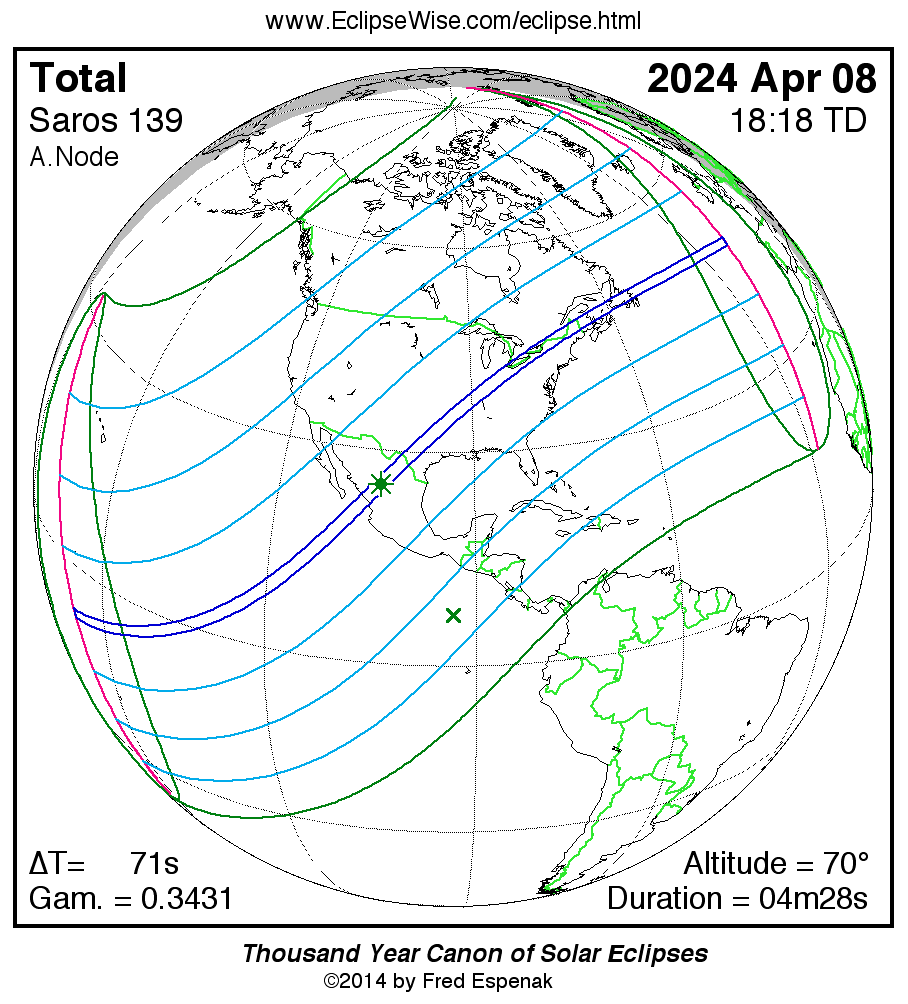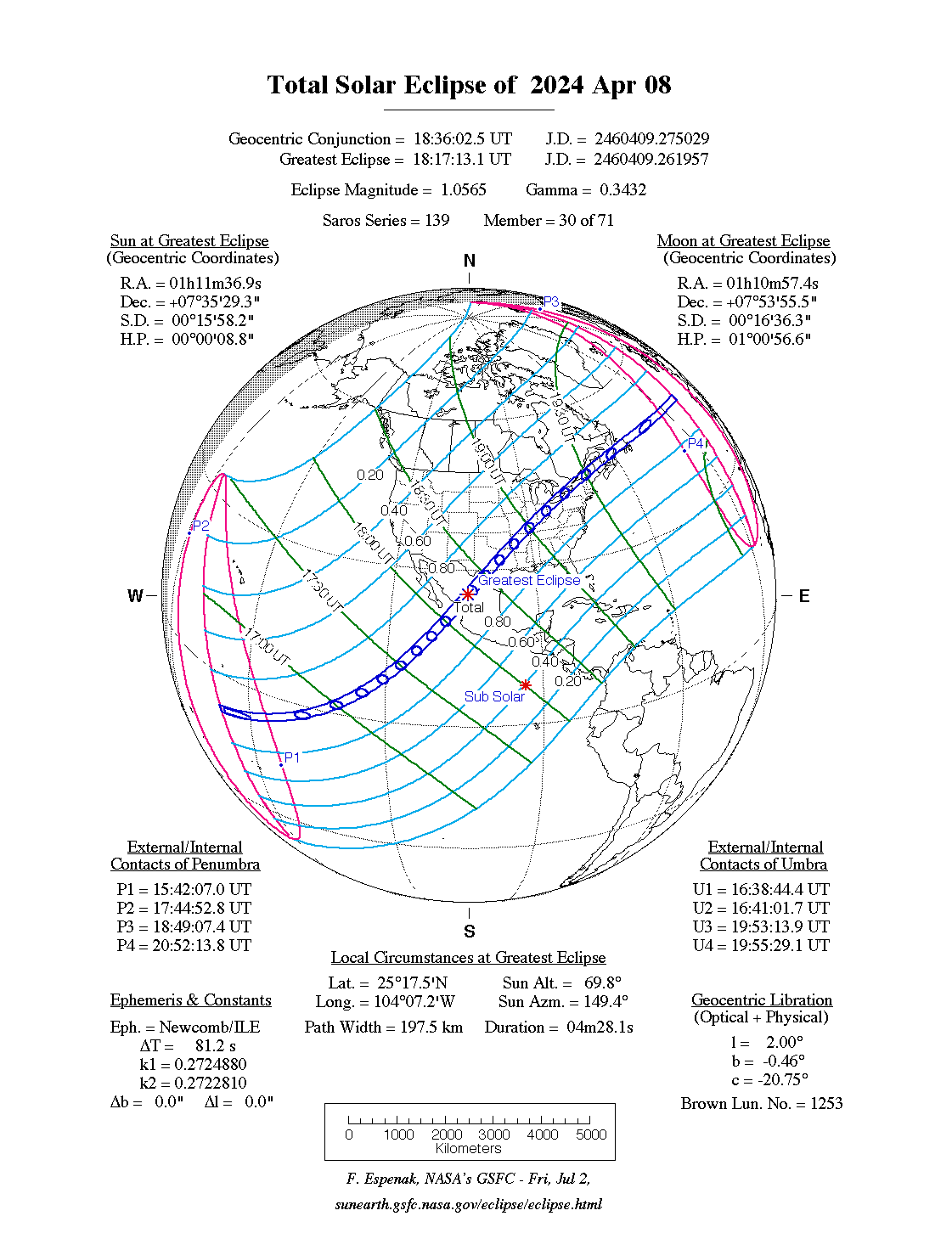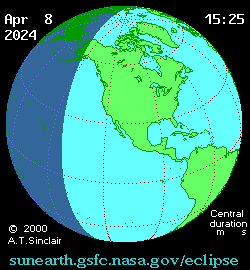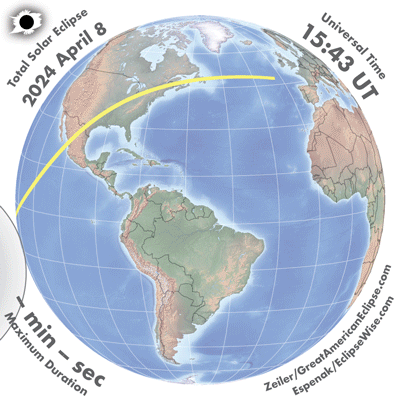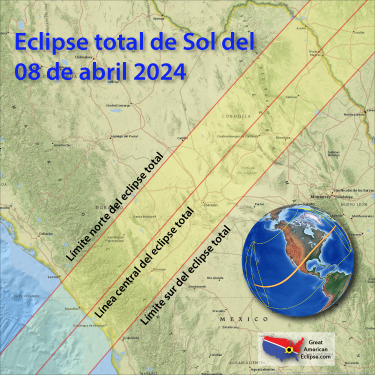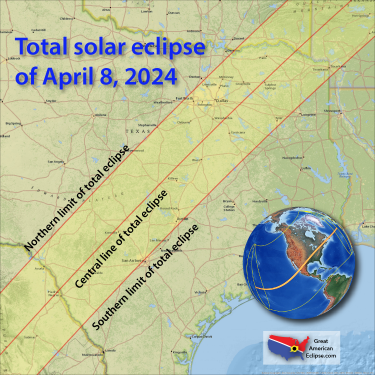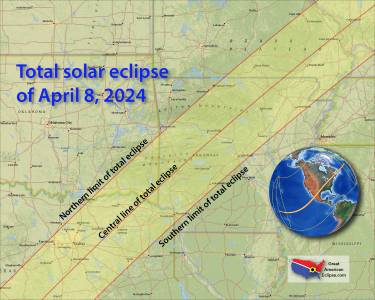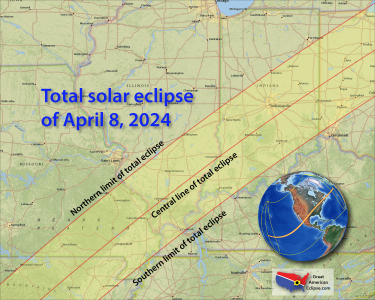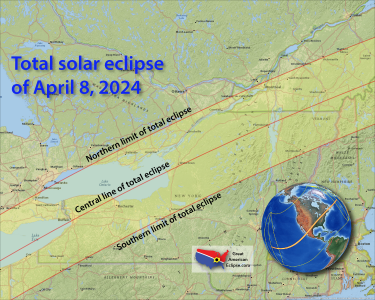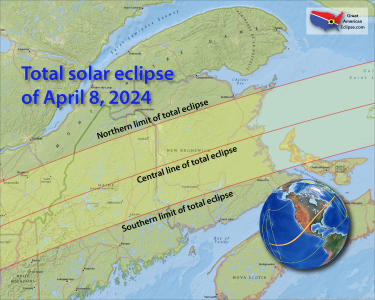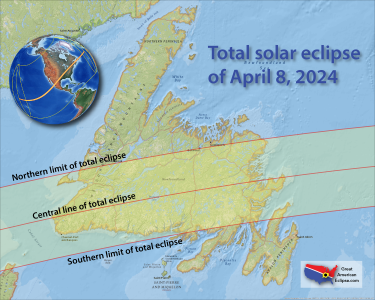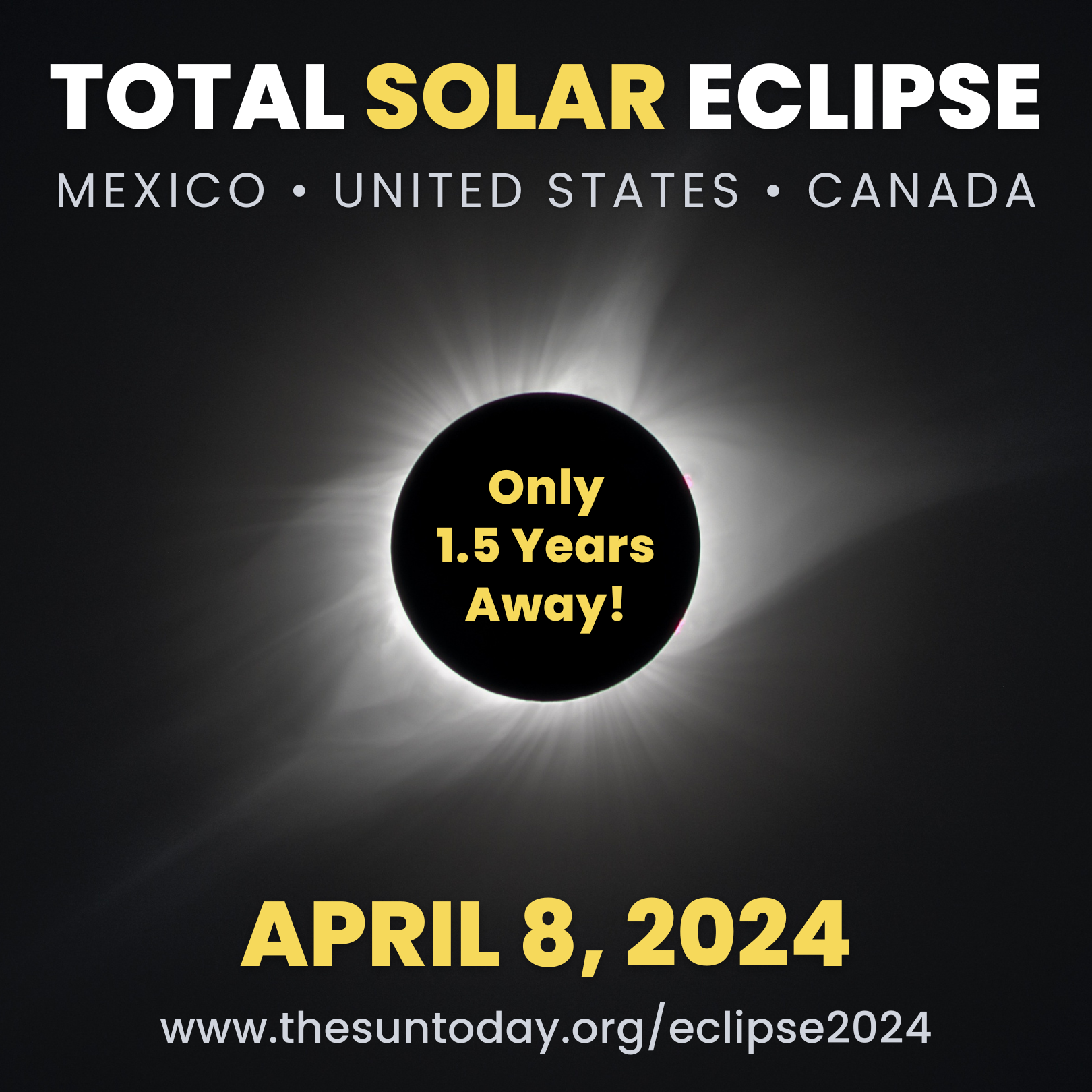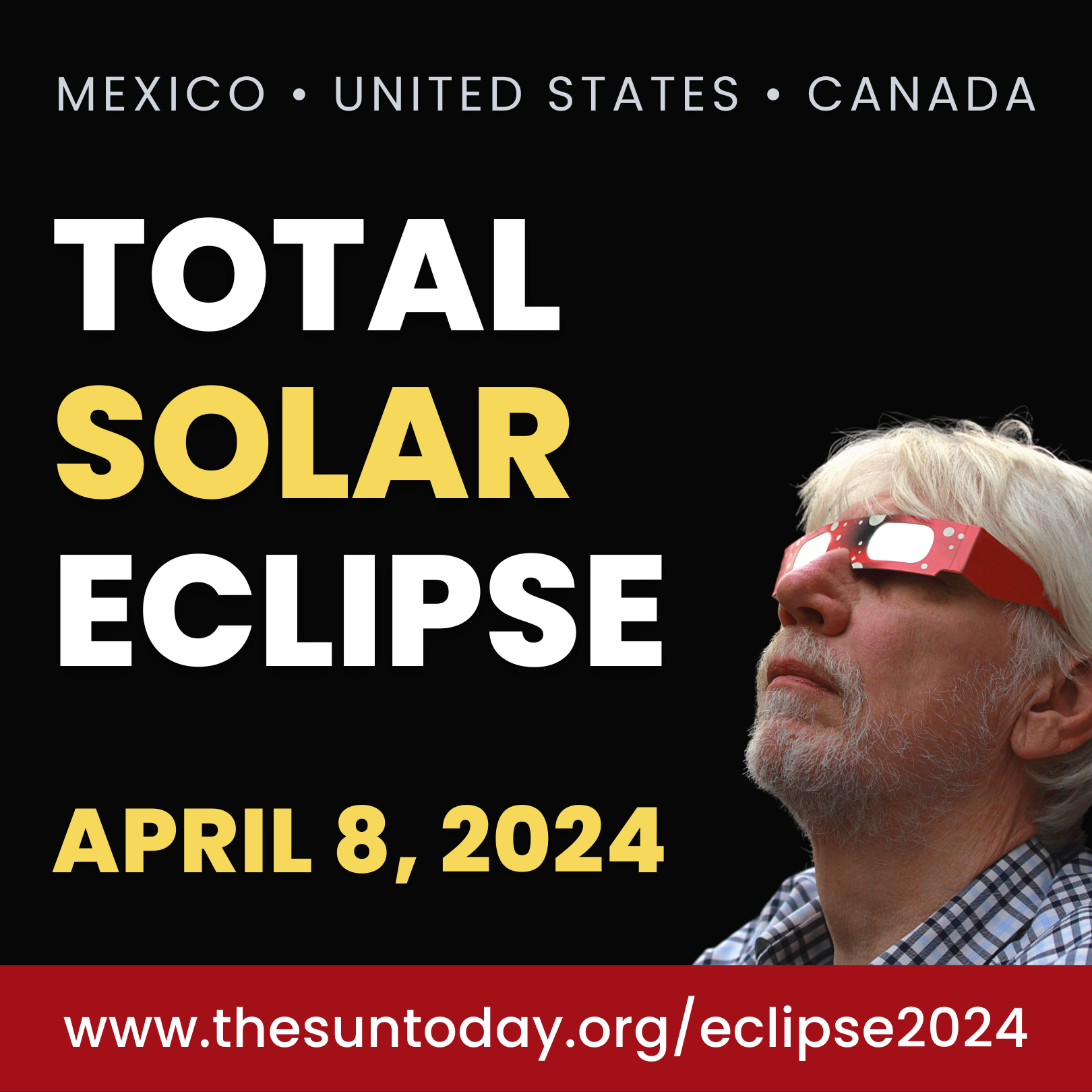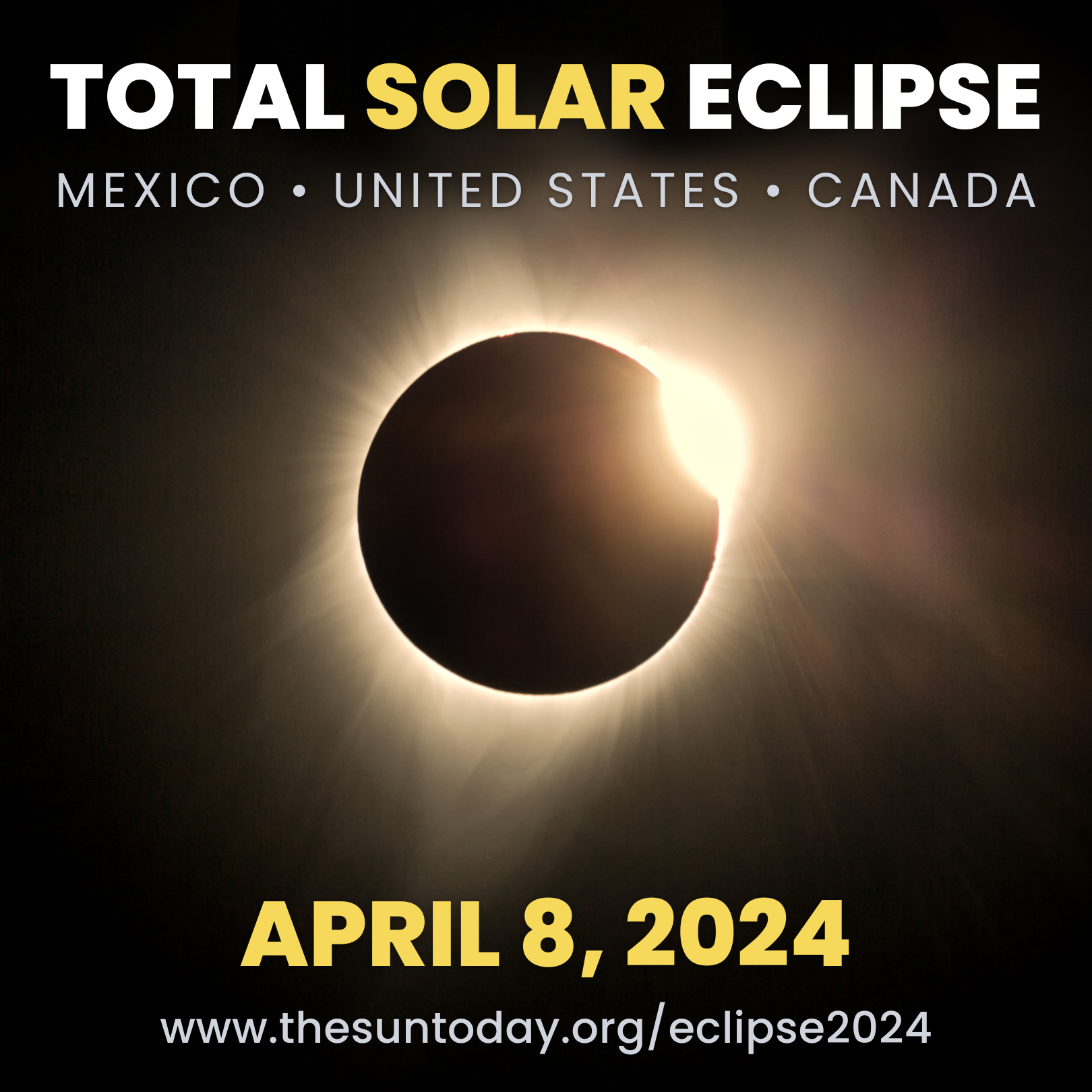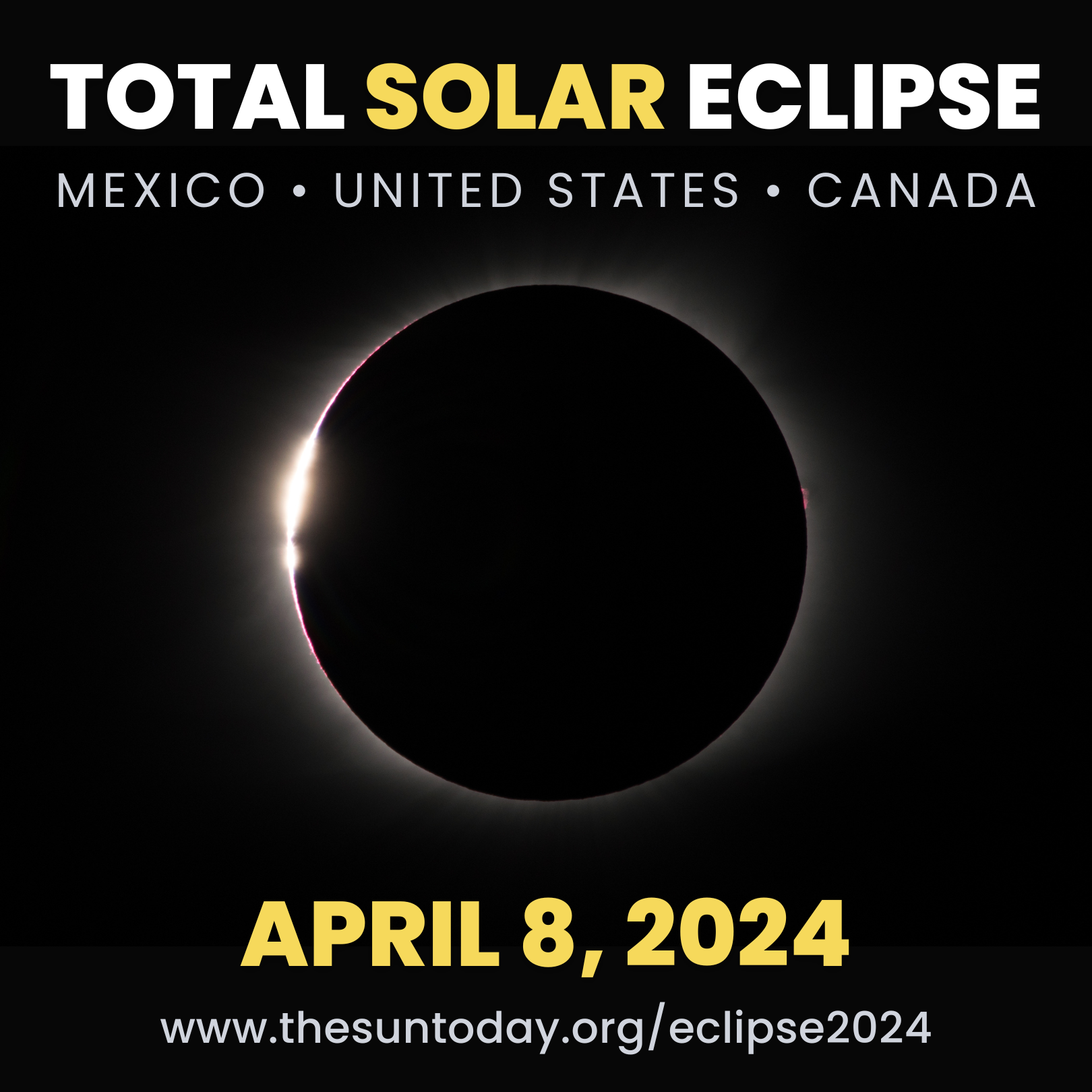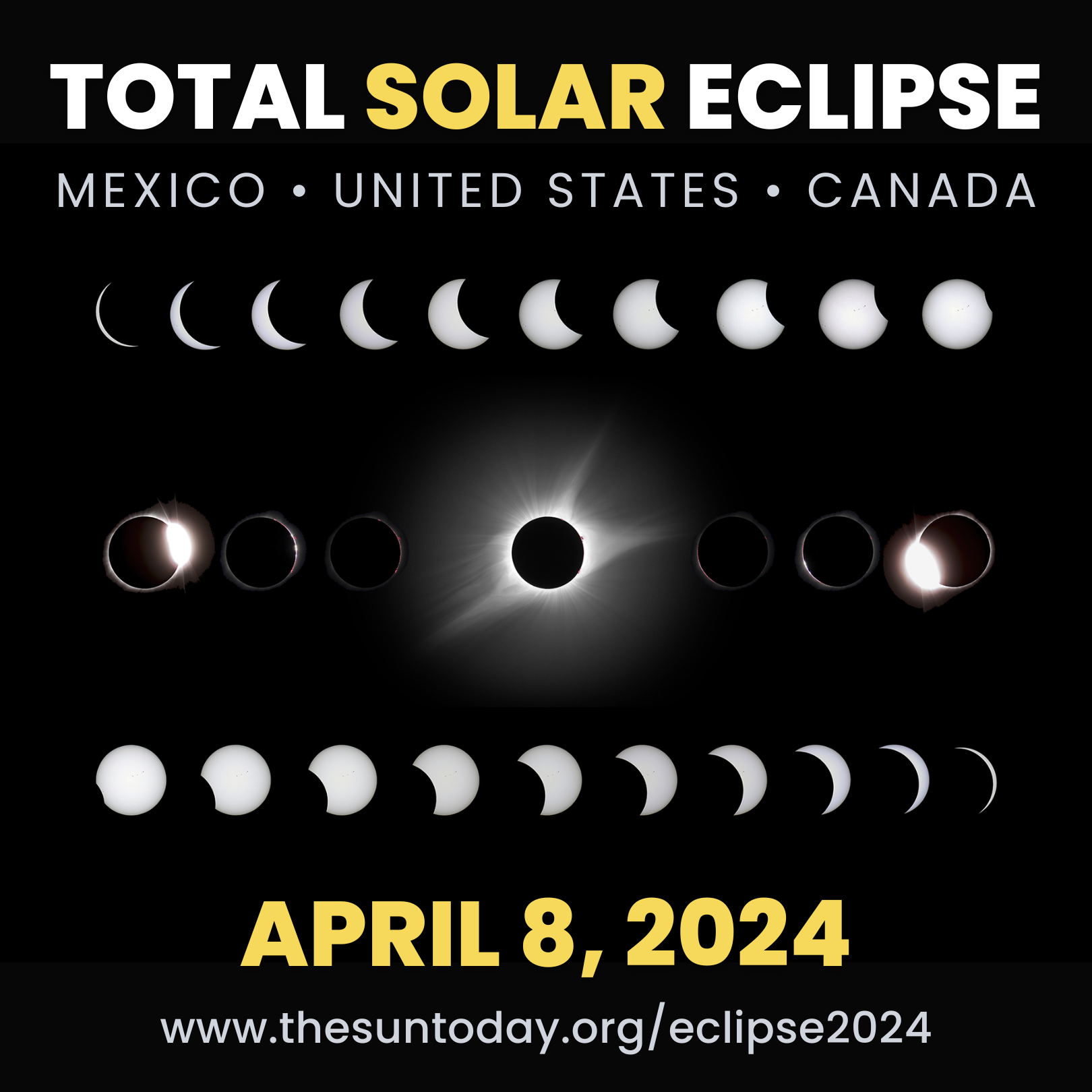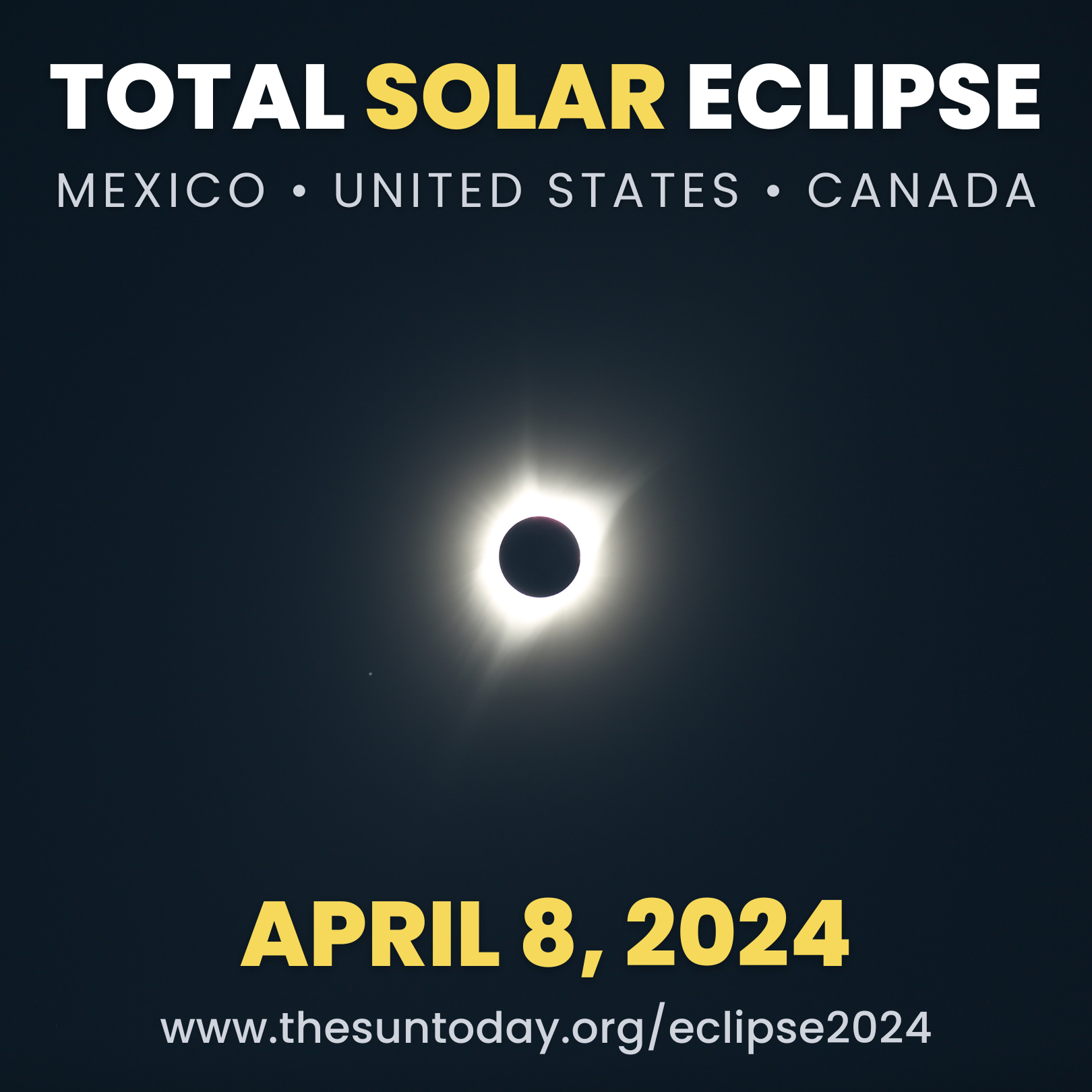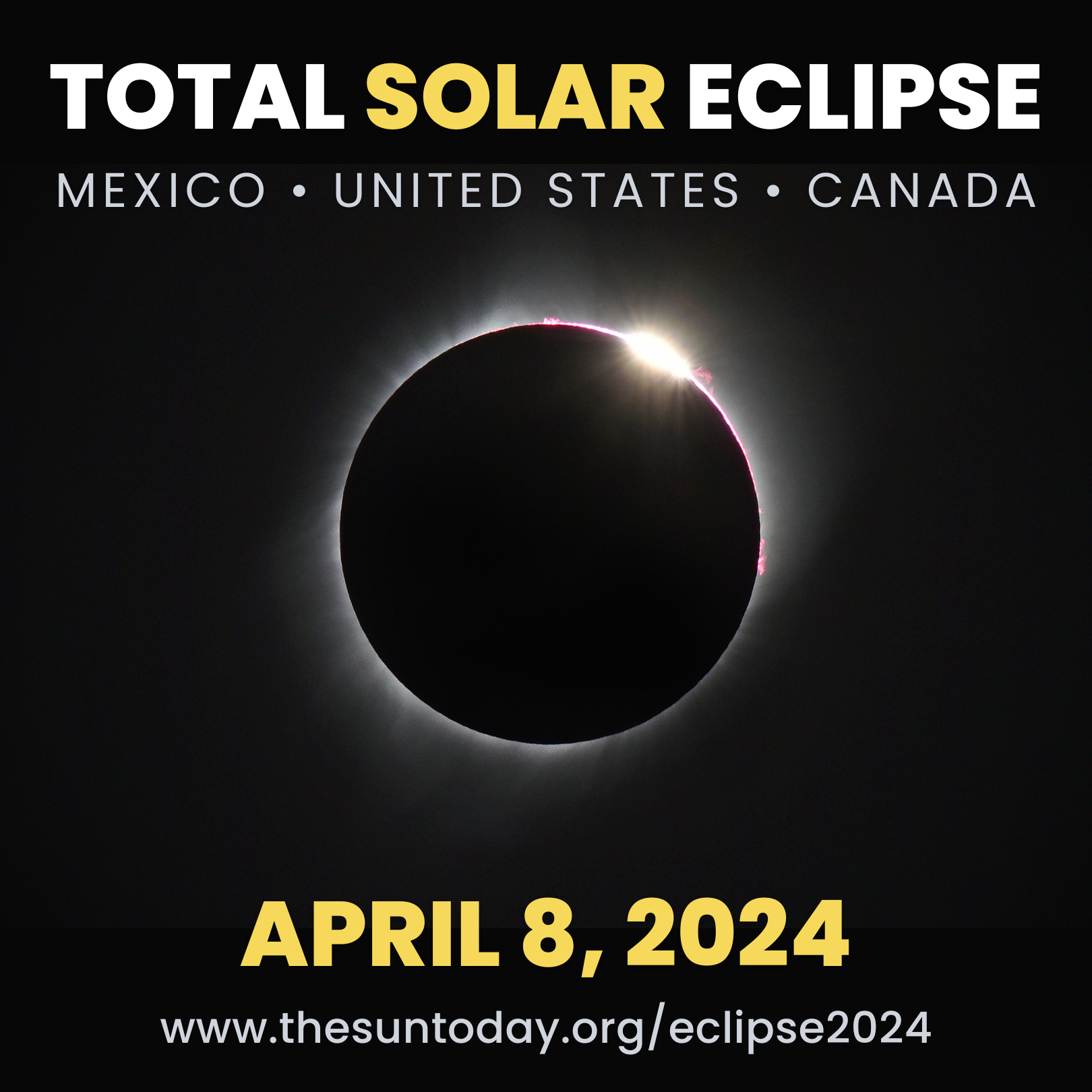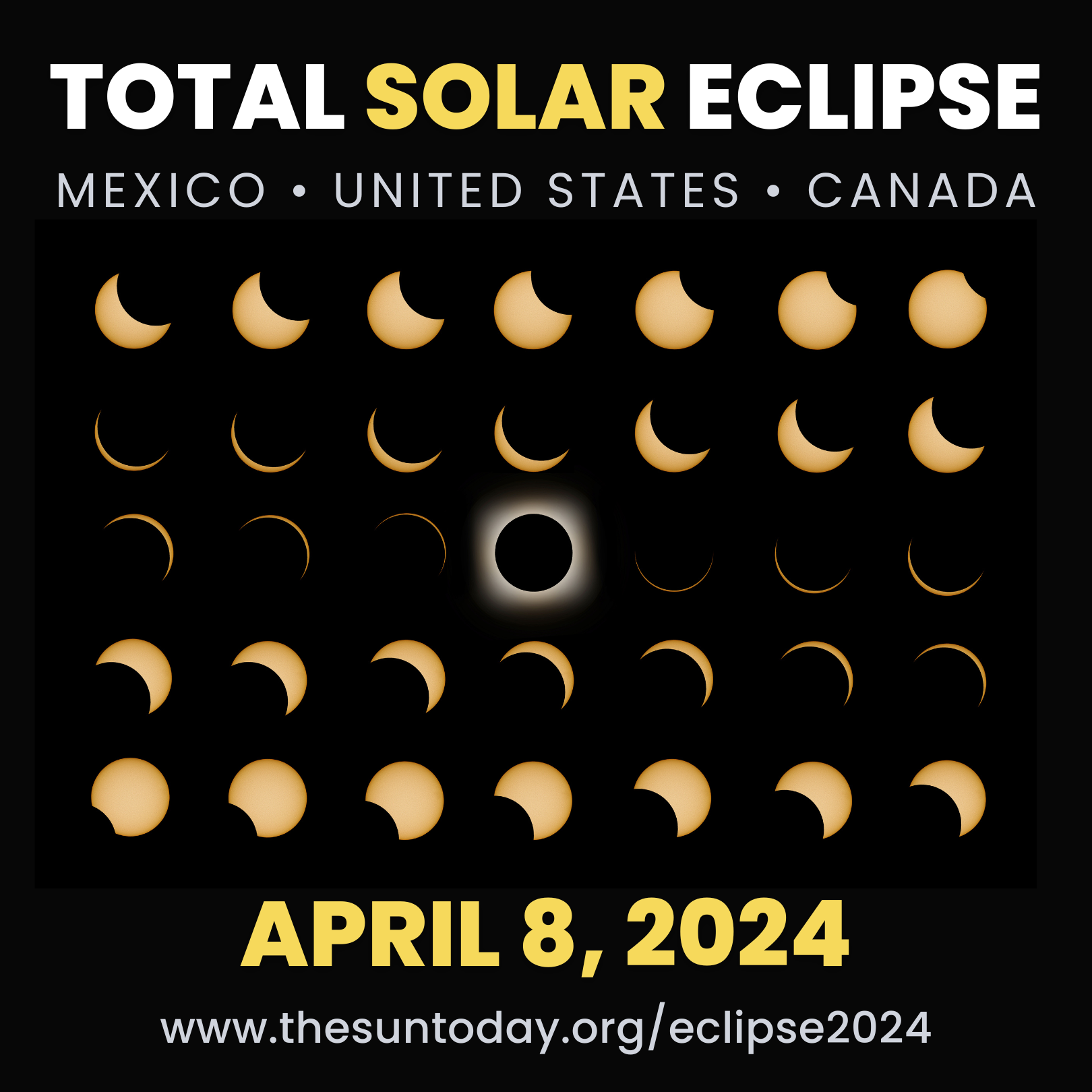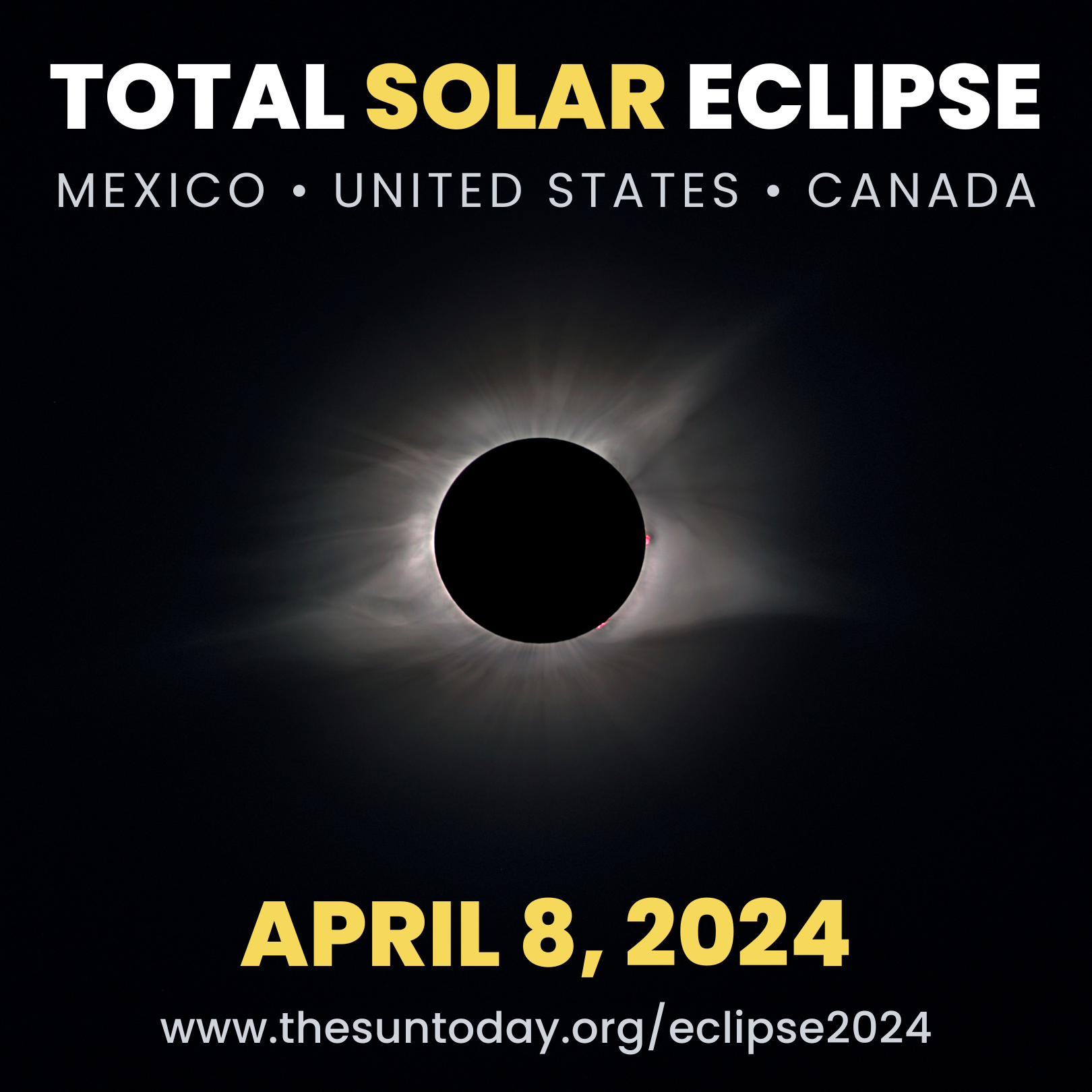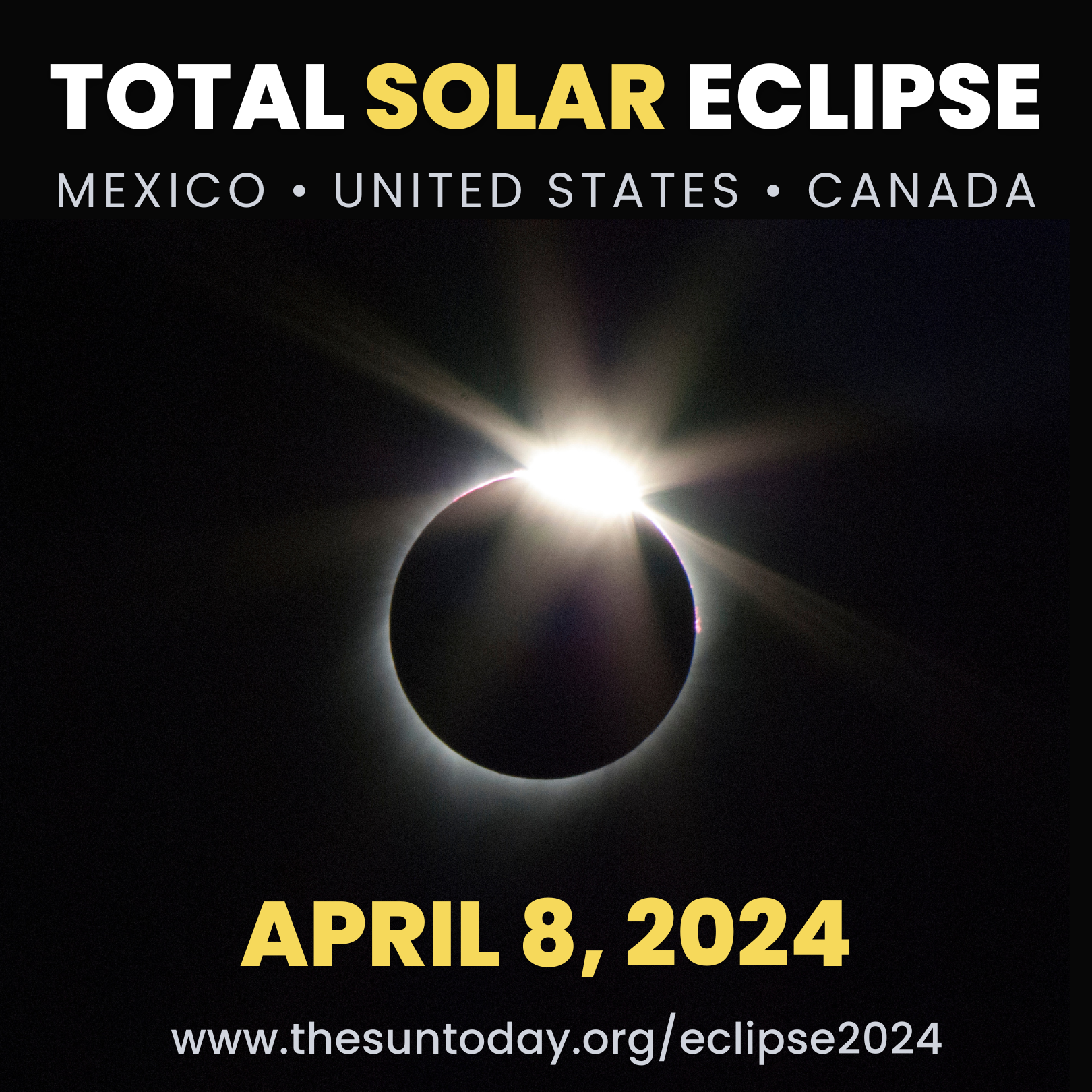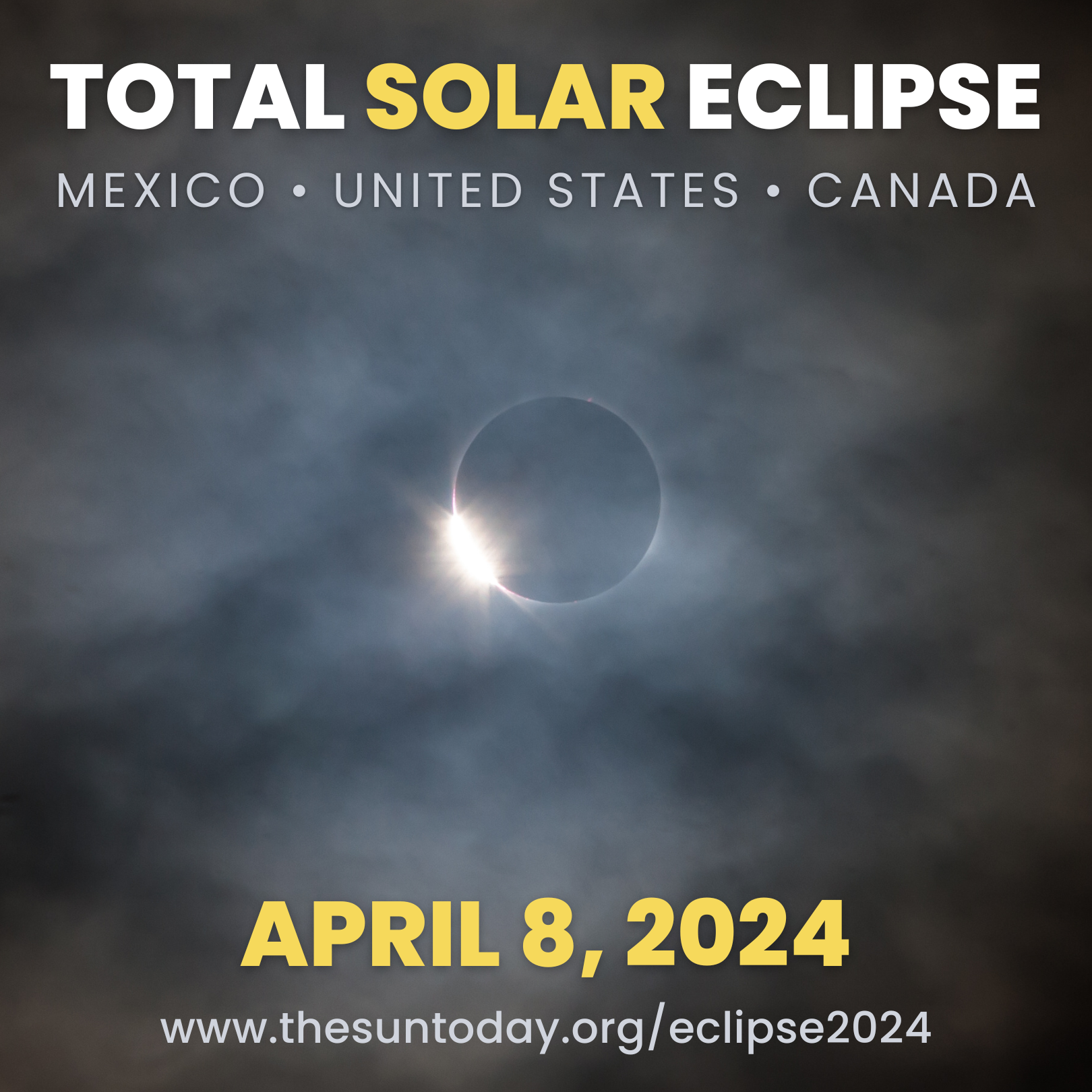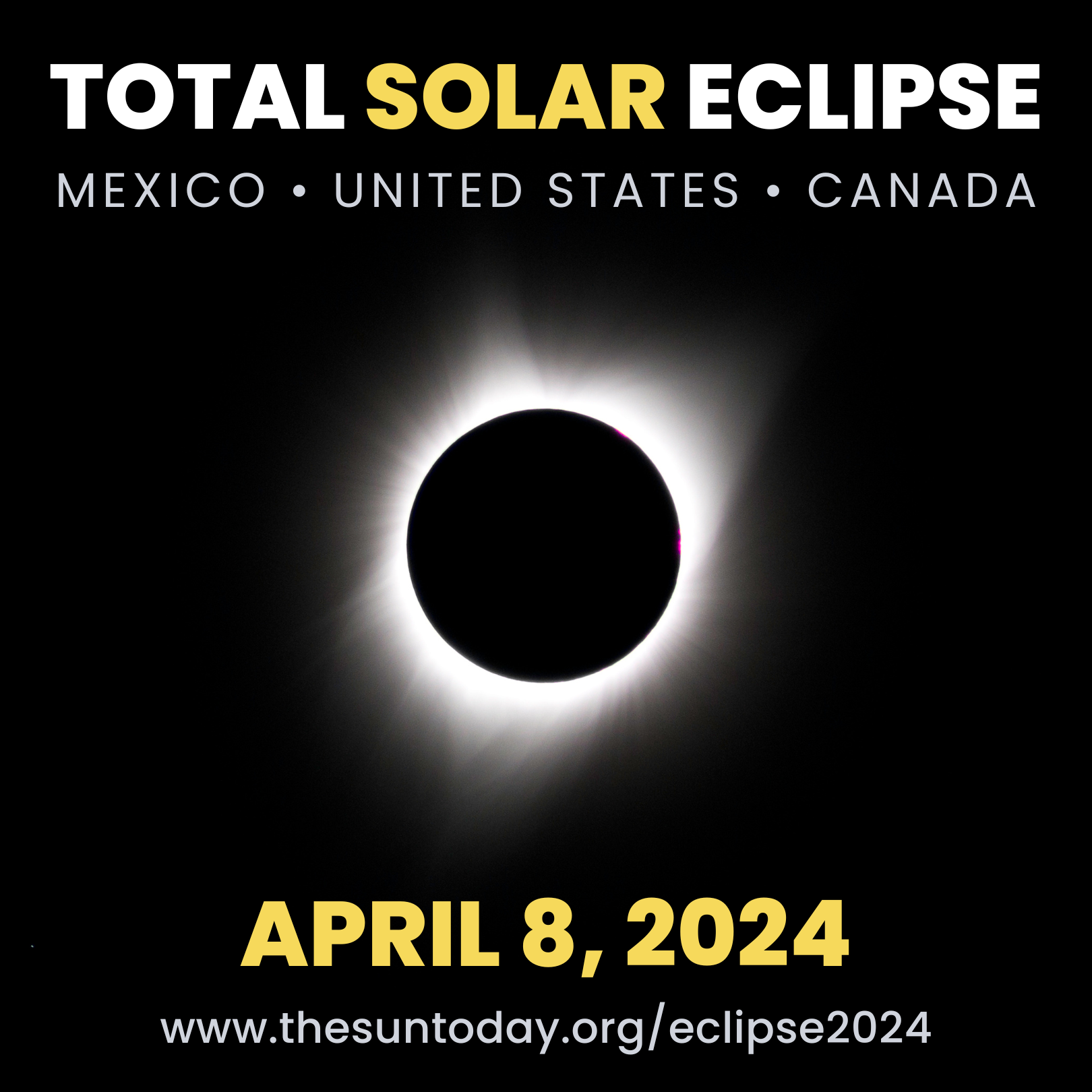Total Solar Eclipse
🌞 🌑 🌎 April 8, 2024 🇲🇽 🇺🇸 🇨🇦
Mexico, United States, and Canada
Totality first touches Mexico, enters the United States at Texas, cuts a diagonal to Maine, and visits the maritime provinces of Canada. The next major total solar eclipse in the US is in 2045, so don’t miss this!
Photo by Karen Kayser
The maximum duration was 4 minutes 28 seconds, in Nazas, Durango, Mexico. The maximum band of totality was 123 mi (198 km).
The 2024 eclipse was visible in parts of the US, Mexico & Canada!
We hope you got to see the April 8, 2024 eclipse! After that, you’ll have to travel because you won’t see another one in the US until 2033 (Alaska), 2044 (Montana and North Dakota), or 2045 across the US!! Did you get to the path of totality in 2024 with no clouds?
There was an annular solar eclipse leading up to April 8, 2024. On October 14, 2023, at 15:03 UTC, it was visible in parts of the United States, Mexico, and several Central American and South American countries.
Before the April 8, 2024, total solar eclipse, the lunar eclipse came on March 24–25, 2024, during the full worm Moon. This wasn’t very exciting, but the big event was!
The virtual camera flies from the night side of the Earth and Moon to the day side, revealing the path of the Moon’s shadow during the April 8, 2024, total solar eclipse. CREDIT: NASA
This page gives details about the eclipse on April 8, 2024. Learn more about the basics of solar eclipses here…

Credit: Rice Space Institute
Occurring only one day after perigee (perigee on April 7, 2024), the Moon’s apparent diameter will be larger than usual.
This eclipse will be the first total solar eclipse to be visible from Canada since February 26, 1979, the first in Mexico since July 11, 1991, and the first in the U.S. since August 21, 2017. It will be the only total solar eclipse in the 21st century where totality is visible in the three-nation set of Mexico, the United States, and Canada.
- Date: Monday, April 8, 2024
- Gamma: 0.3431
- Magnitude: 1.0566
- Saros: 139 (30 of 71)
- Greatest eclipse: 7:34:38
- Max. width of band: 419 km (260 mi)
The animation of the April 8, 2024, total solar eclipse shows the Moon’s shadows as they sweep across a global map of Earth (an orthographic projection). The vantage point of the animation is seen from the Moon. The daylight hemisphere of Earth then faces the Moon and the lunar shadows appear perfectly circular with no distorted projection effects as they race across Earth. Another consequence of this viewing geometry is that the Moon’s shadows move across the disk of Earth in a straight line.
The Moon’s umbral shadow appears as a small black disk and tracks along the path of totality (yellow strip). The much larger penumbral shadow is lightly shaded and outlined with a solid black edge. A partial eclipse is visible from within the penumbra, while a total eclipse is visible inside the umbra.
CREDIT: GreatAmericanEclipse.com
Watch the Eclipse Replays!
The Weather Channel
Did you catch C. Alex Young on the live show? TWC team was LIVE along the path of totality with interviews, weather updates & telescope feeds for the Total Solar Eclipse on Monday! Watch on The Weather Channel or stream on your favorite device at streamtwc.com. Stephanie Abrams had a similar view to us since she was also in Fredericksburg, TX. The clouds broke differently, and she saw the diamond ring. It just shows that you can be so close yet so far. ![]()
![]()


McDonald Observatory

Associated Press

timeanddate

Exploratorium

NASA

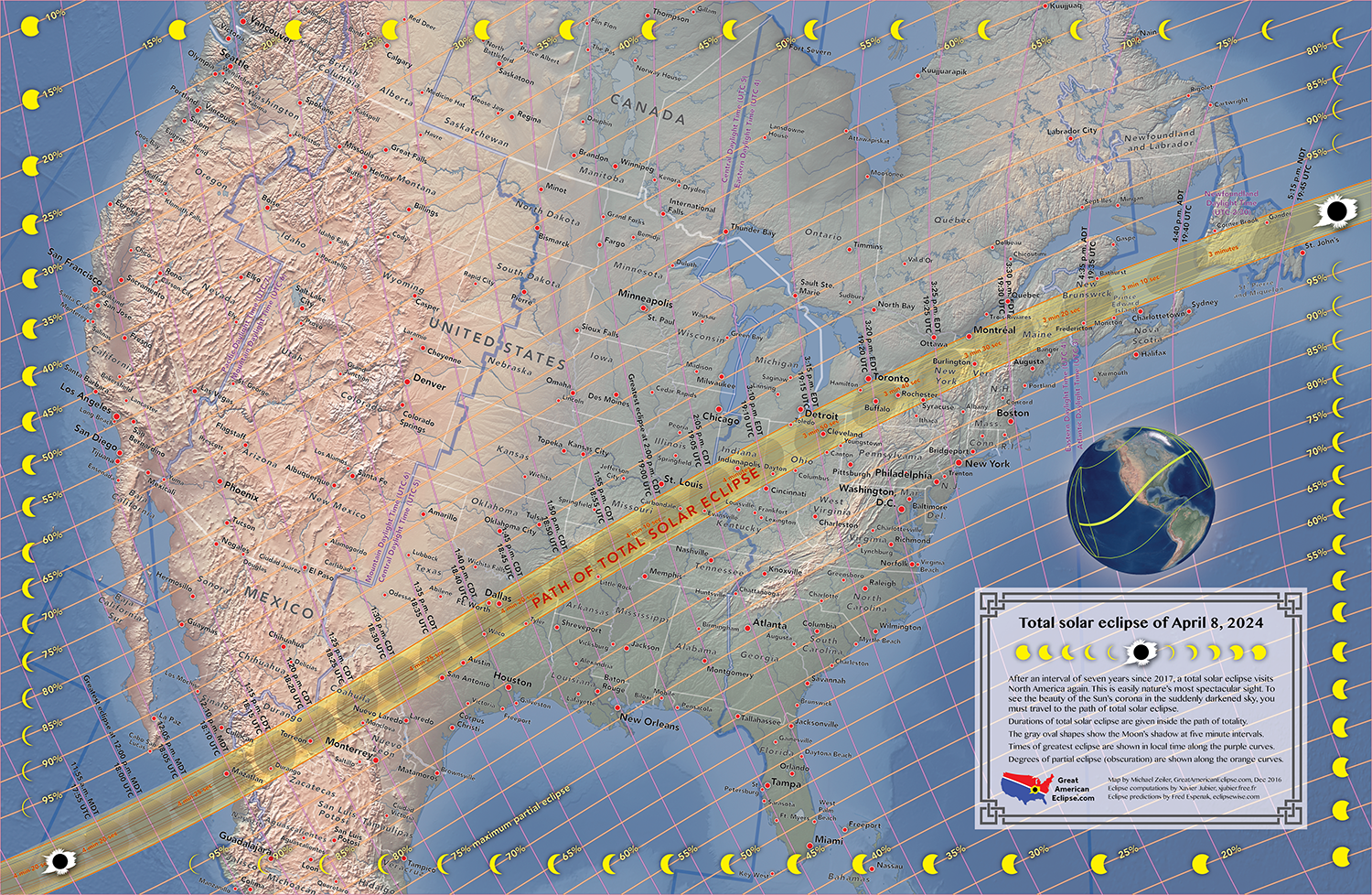
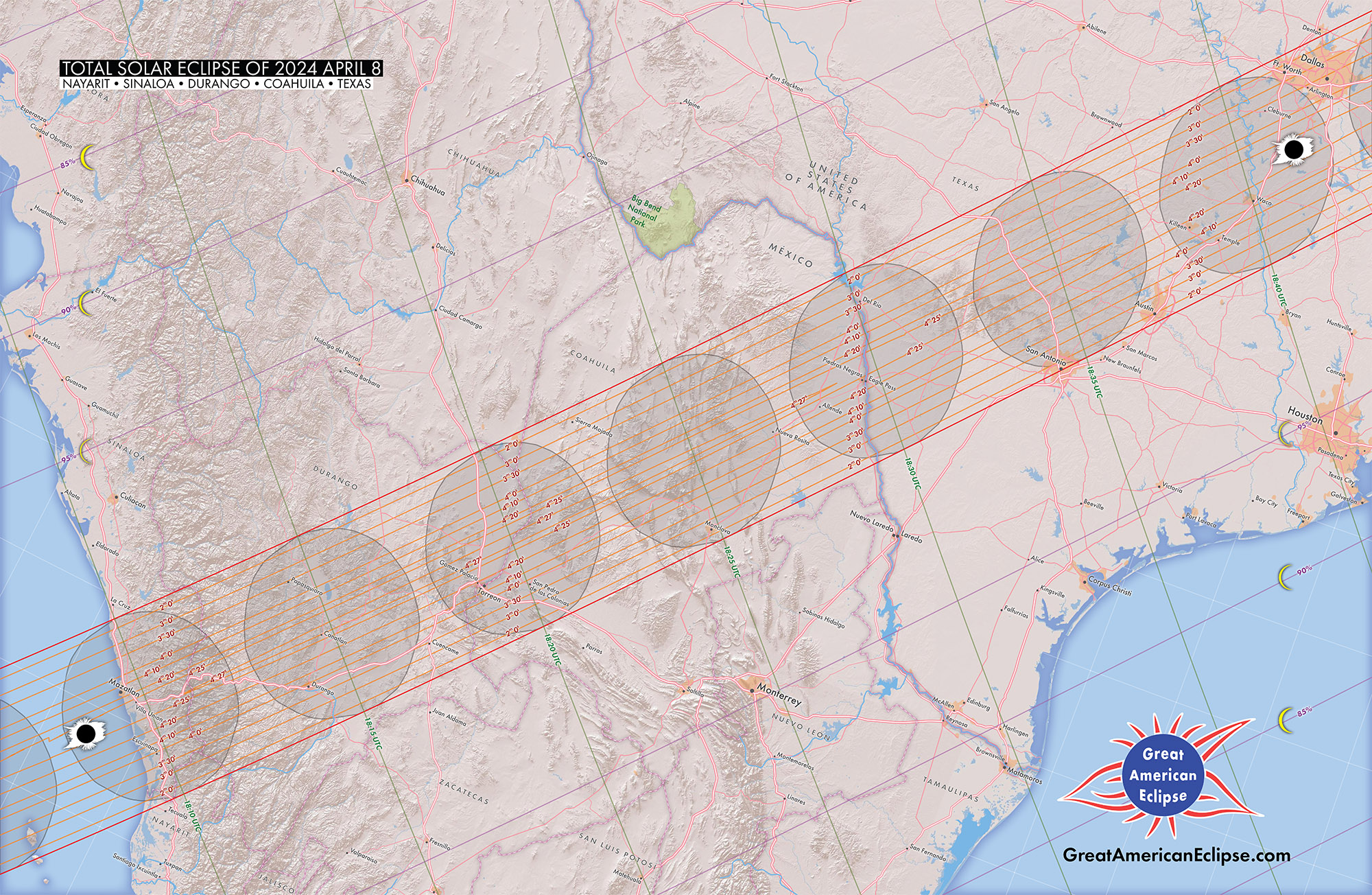
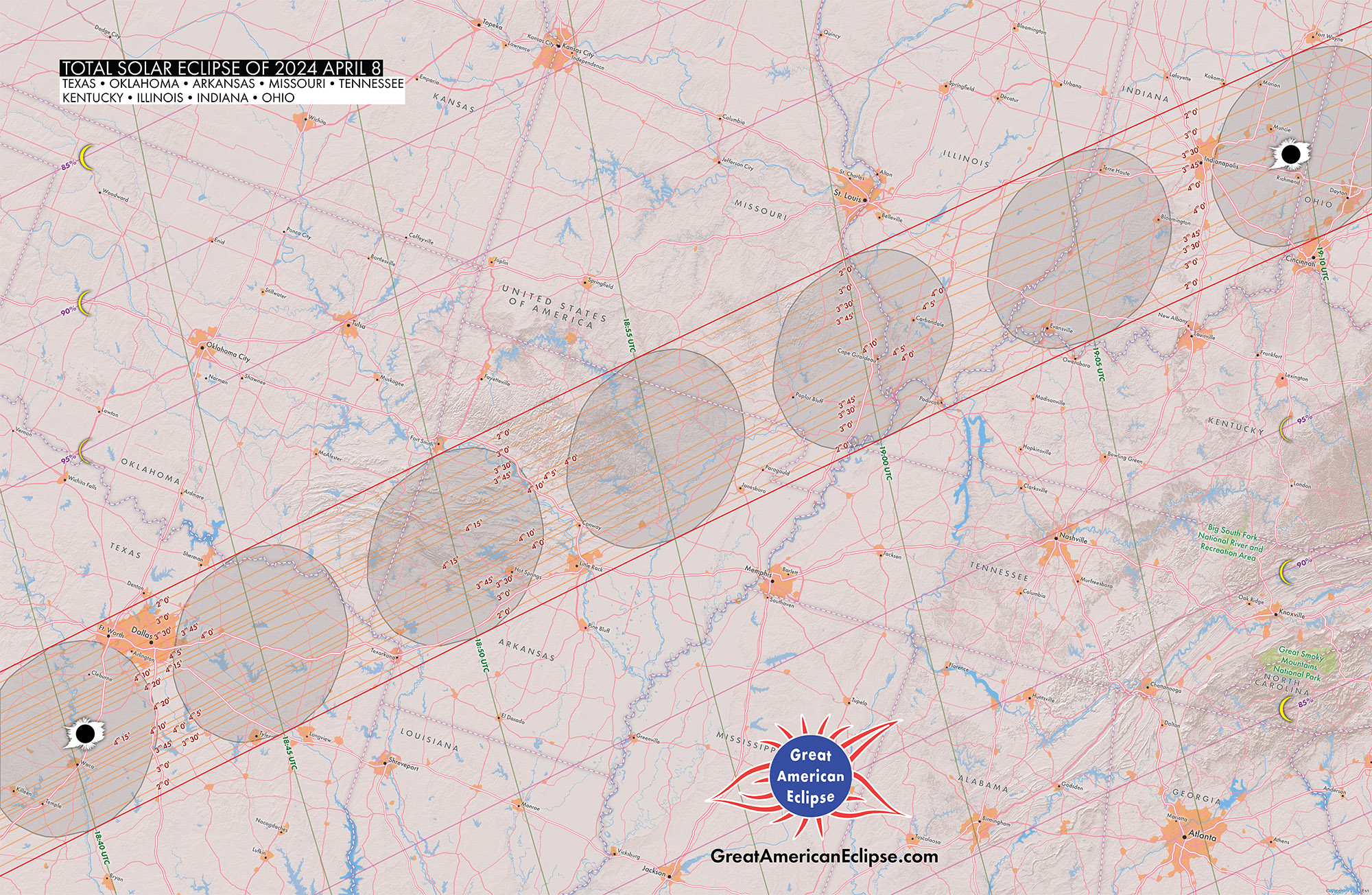
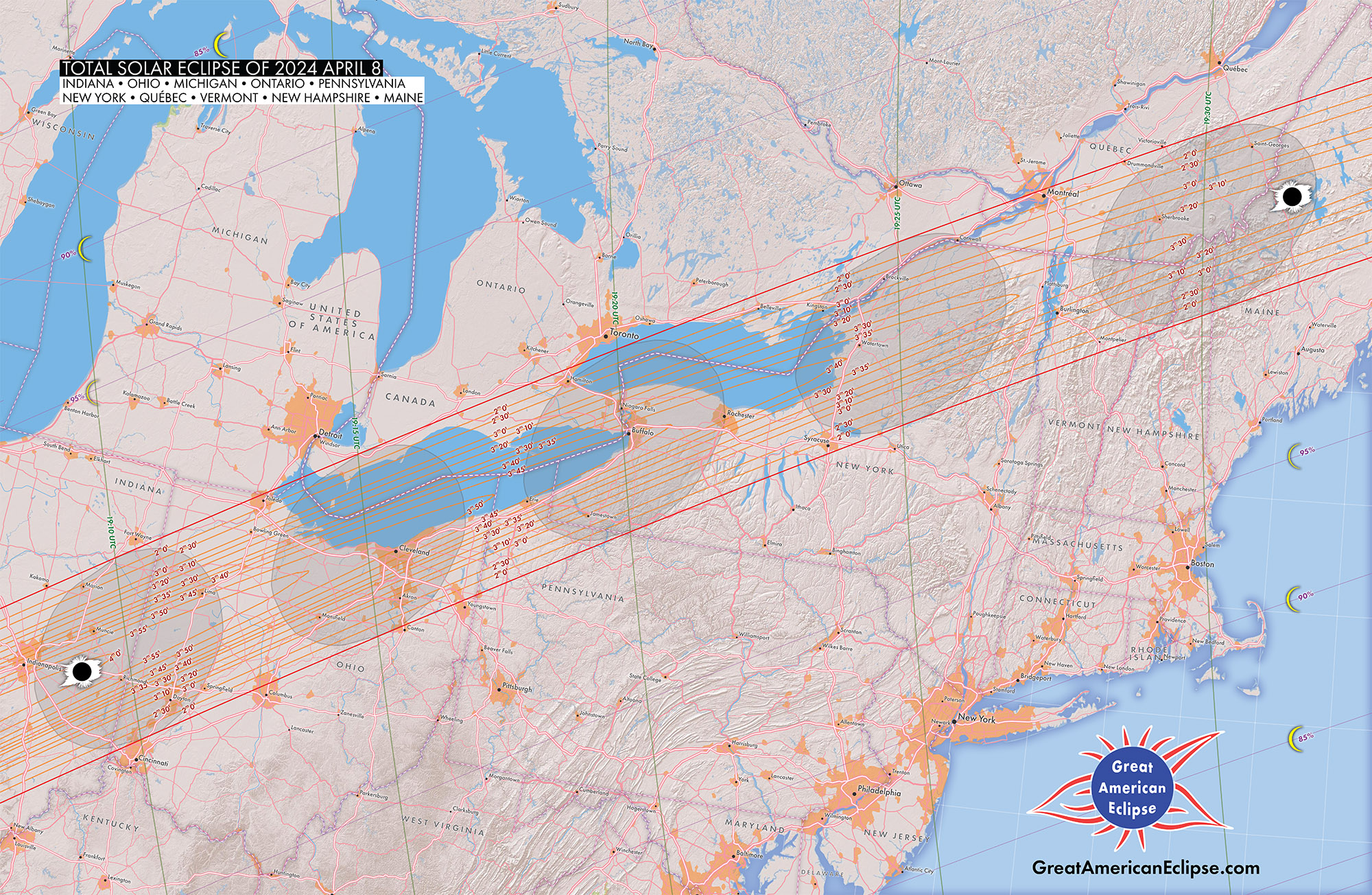
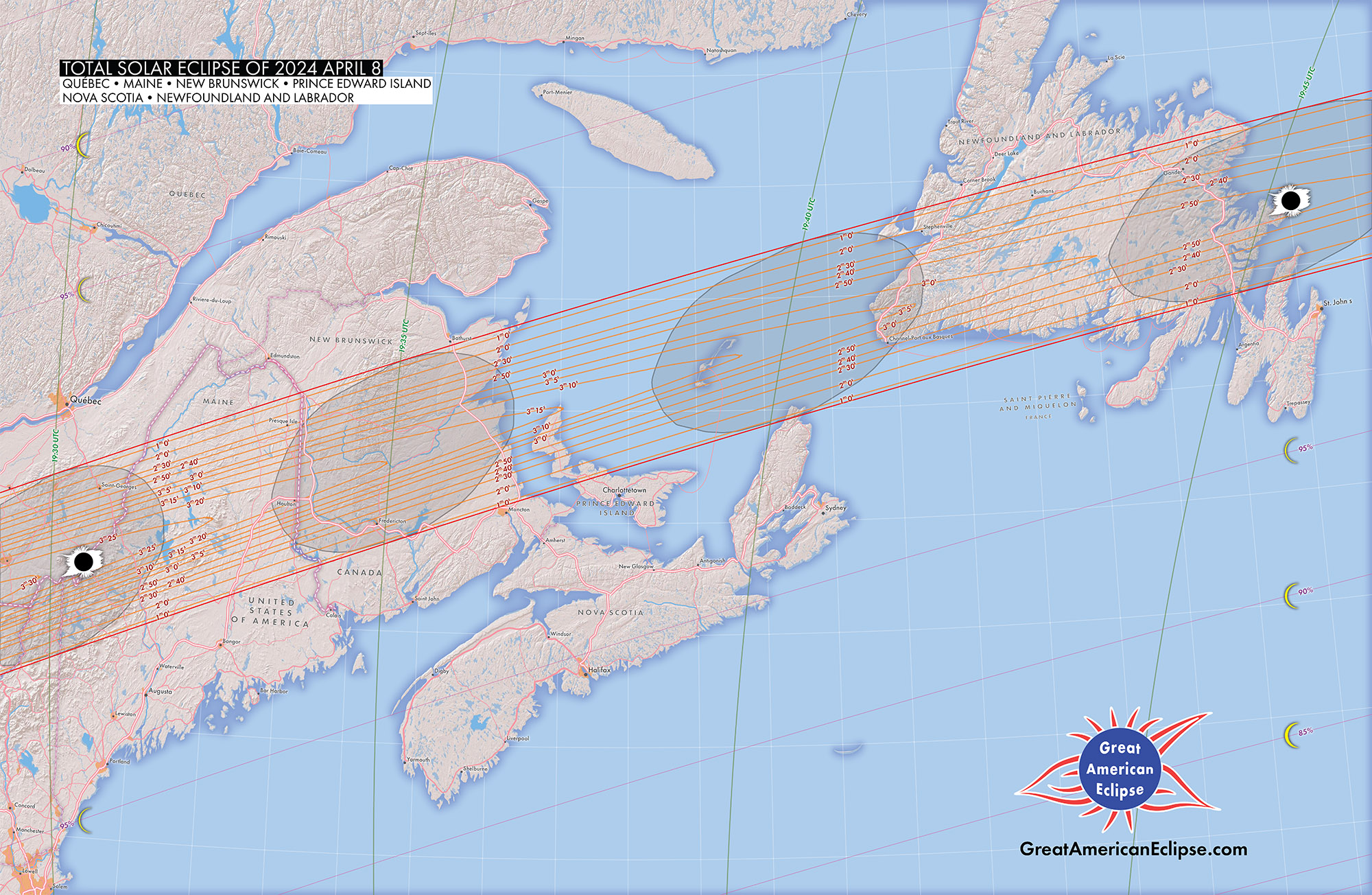
April 8, 2024 Total Solar Eclipse – When and where can you see it?
The eclipse starts at one location and ends at another. The times below are actual times (in UTC) when the eclipse occurs. (Credit: timeanddate.com)
| Event | UTC Time | Time in Washington DC* |
|---|---|---|
| The first location to see the partial eclipse begin | Apr 8 at 15:42:10 | Apr 8 at 11:42:10 am |
| The first location to see the full eclipse begin | Apr 8 at 16:38:47 | Apr 8 at 12:38:47 pm |
| Maximum Eclipse | Apr 8 at 18:17:16 | Apr 8 at 2:17:16 pm |
| Last location to see the full eclipse end | Apr 8 at 19:55:32 | Apr 8 at 3:55:32 pm |
| Last location to see the partial eclipse end | Apr 8 at 20:52:14 | Apr 8 at 4:52:14 pm |
* These local times do not refer to a specific location but indicate the beginning, peak, and end of the eclipse on a global scale, with each line referring to a different location. Please note that the local times for Washington DC are meant as a guideline in case you want to view the eclipse via a live webcam. They do not mean that the eclipse is necessarily visible there.
When the Eclipse Happens at Specific Locations — Timeline
A few select locations within the path of totality. The eclipse begins and ends as a partial eclipse. The beginning, maximum, and end of annularity are listed between the partial phases. Credit: NASA
| Location | Partial Begins | Totality Begins | Maximum | Totality Ends | Partial Ends |
|---|---|---|---|---|---|
| Dallas, Texas | 12:23 p.m. CDT | 1:40 p.m. CDT | 1:42 p.m. CDT | 1:44 p.m. CDT | 3:02 p.m. CDT |
| Idabel, Oklahoma | 12:28 p.m. CDT | 1:45 p.m. CDT | 1:47 p.m. MDT | 10:49 p.m. MDT | 3:06 p.m. CDT |
| Little Rock, Arkansas | 12:33 p.m. CDT | 1:51 p.m. CDT | 1:52 p.m. CDT | 1:54 p.m. CDT | 3:11 p.m. CDT |
| Poplar Bluff, Missouri | 12:39 p.m. CDT | 1:56 p.m. CDT | 1:56 p.m. CDT | 2:00 p.m. CDT | 3:15 p.m. CDT |
| Paducah, Kentucky | 12:42 p.m. CDT | 2:00 p.m. CDT | 2:01 p.m. CDT | 2:02 p.m. CDT | 3:18 p.m. CDT |
| Evansville, Indiana | 12:45 p.m. CDT | 2:02 p.m. CDT | 2:04 p.m. CDT | 2:05 p.m. CDT | 3:20 p.m. CDT |
| Cleveland, Ohio | 1:59 p.m. EDT | 3:13 p.m. EDT | 3:15 p.m. EDT | 3:17 p.m. EDT | 4:29 p.m. EDT |
| Erie, Pennsylvania | 2:02 p.m. EDT | 3:16 p.m. EDT | 3:18 p.m. EDT | 3:20 p.m. EDT | 4:30 p.m. EDT |
| Buffalo, New York | 2:04 p.m. EDT | 3:18 p.m. EDT | 3:20 p.m. EDT | 3:22 p.m. EDT | 4:32 p.m. EDT |
| Burlington, Vermont | 2:14 p.m. EDT | 3:26 p.m. EDT | 3:27 p.m. EDT | 3:29 p.m. EDT | 4:37 p.m. EDT |
| Lancaster, New Hampshire | 2:16 p.m. EDT | 3:27 p.m. EDT | 3:29 p.m. EDT | 3:30 p.m. EDT | 4:38 p.m. EDT |
| Caribou, Maine | 2:22 p.m. EDT | 3:32 p.m. EDT | 3:33 p.m. EDT | 3:34 p.m. EDT | 4:40 p.m. EDT |
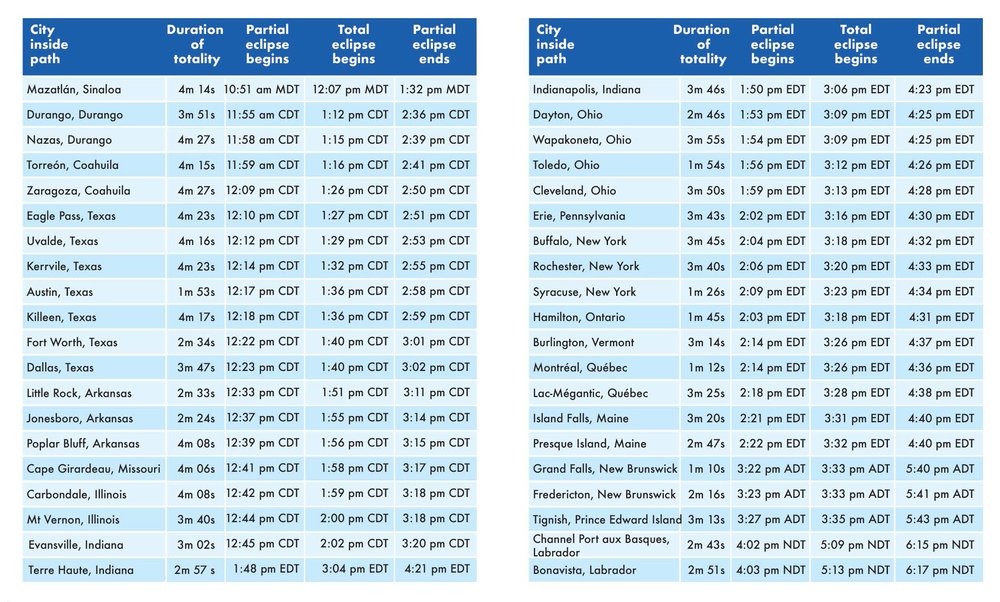
THESE ARE THE TIMES AND DURATIONS OF THE ECLIPSE AT POINTS INSIDE THE PATH OF TOTAL SOLAR ECLIPSE – Credit: GreatAmericanEclipse.com
Detailed Maps
Total Solar Eclipse – April 8, 2024
Click the images to view larger & a caption with details.
CREDIT: GreatAmericanEclipse.com
Animations of the April 8, 2024 Eclipse Umbral Shadow
A shadow animation across Mexico. CREDIT: www.greatamericaneclipse.com
A shadow animation across the United States. CREDIT: www.greatamericaneclipse.com
A shadow animation across Canada. CREDIT: www.greatamericaneclipse.com
Flyovers of the April 8, 2024 Eclipse Umbral Shadow
This visualization closely follows the Moon’s umbra shadow as it crosses North America during the April 8, 2024 total solar eclipse. It covers the one hour and 50 minutes between 10:57 a.m. Pacific Standard Time and 4:47 p.m. Atlantic Daylight Time. Annotations include a running clock and the location of the center of the shadow. Everyone within the dark oval sees totality. CREDIT: NASA SVS
A shadow flyover Mexico, CREDIT: www.greatamericaneclipse.com
A shadow flyover the United States, CREDIT: www.greatamericaneclipse.com
A shadow flyover Canada, CREDIT: www.greatamericaneclipse.com
How is the April 8, 2024 total solar eclipse different from the August 21, 2017 eclipse?
The August 21, 2017, and April 8, 2024, total solar eclipses are important astronomical events, but there are some important differences between them. The eclipse in April 2024 differs from the eclipse in August 2017 in the following ways:
Path Across the Earth
Parts of Mexico, the United States, and Canada will be included in the eclipse’s totality path, traversing North America from southwest to northeast in April 2024. The eclipse in August 2017 crossed only the United States from northwest to southeast. The different paths mean distinct regions will experience totality, providing new places the opportunity to see this exceptional occurrence. This also means more than 31 million people will have the opportunity to see totality in 2024, compared to 20 million in 2017.
Width and Duration of Totality
Compared to the August 2017 eclipse, the April 2024 eclipse’s total phase will be longer at its longest point. The 2017 eclipse had a maximum duration of roughly 2 minutes and 38 seconds; in 2024, the maximum duration will be approximately 4 minutes and 28 seconds. This extended duration gives those in the path of totality more opportunity to witness the dramatic elements of the eclipse, like Bailey’s beads and the corona. This increased duration results from the Moon being closer to Earth in 2024 than in 2017. This closer distance creates a larger Moon shadow so that the path of totality has a larger average width. The width in 2017 ranged from 62 to 71 miles (100 to 114). The width for 2024 ranges from 108 to 122 miles (174 to 196 km).
Seasonal Weather Patterns
The eclipse in August 2017 occurred in late summer, but the eclipse in April 2024 will happen in early spring. Seasonal differences in the weather might impact viewing conditions. For instance, in some places, April may have more erratic weather, including the potential for spring storms. In contrast, in many areas that saw totality in 2017, August often offers a more consistent, brighter sky.
Sun’s location in the Sky
During an eclipse, the Sun’s location in the sky varies depending on the season. Compared to the lower location during the August 2017 eclipse, the Sun will be higher in the sky for many North American observers when the eclipse occurs in April 2024. Different observational dynamics and chances of photography may arise from a higher sun position.
Public Interest and Preparation
The August 2017 total solar eclipse, dubbed the “Great American Eclipse,” attracted much attention from the general public and led to several watching events nationwide. Building on the experiences and knowledge gained from 2017, there might be even greater expectations and preparation within the scientific and public sectors for the eclipse in 2024, which will happen just seven years later.
All of these differences highlight the fact that every eclipse is a unique experience, always offering a new view of such an amazing natural experience to onlookers, eclipses chasers, and scientists.
